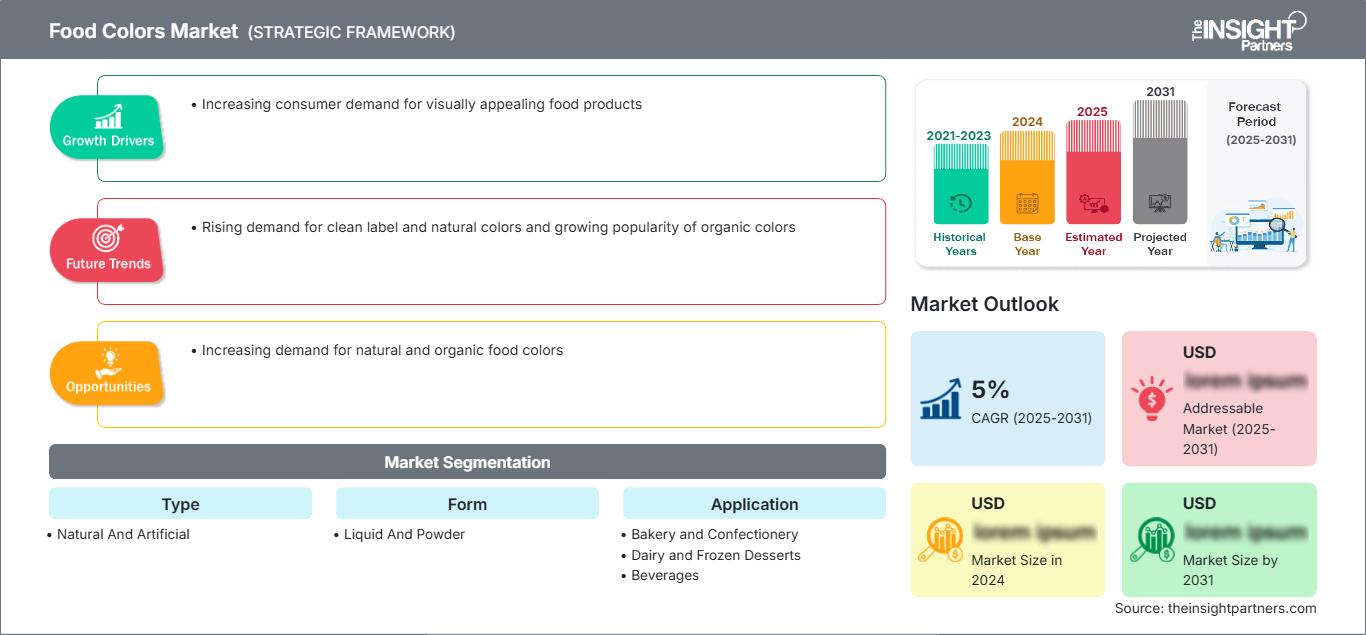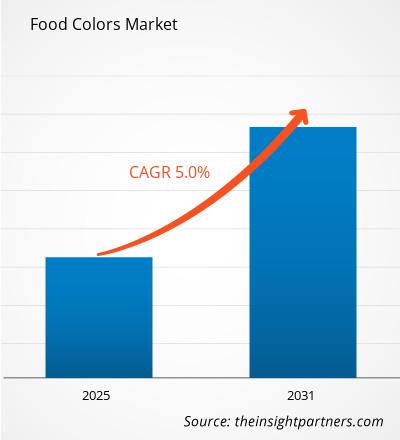Der Markt für Lebensmittelfarben wird bis 2031 voraussichtlich ein Volumen von 6,55 Milliarden US-Dollar erreichen. Für den Zeitraum 2025–2031 wird ein jährliches Wachstum von 6,7 % erwartet. Die steigende Nachfrage nach Produkten mit transparenten Inhaltsangaben und natürlichen Farbstoffen sowie die zunehmende Beliebtheit von Bio-Farben dürften weiterhin ein wichtiger Markttrend bleiben.
Marktanalyse für Lebensmittelfarben
- Der globale Markt für Lebensmittelfarben wächst mit einer signifikanten Rate. Zu den dafür verantwortlichen Faktoren zählen die steigende Nachfrage nach verarbeiteten Lebensmitteln und Fertiggerichten, die Neigung der Verbraucher zu verbessertem Geschmack, Textur und Aussehen sowie wichtige treibende Faktoren wie die rasche Urbanisierung, veränderte Ernährungsgewohnheiten und steigende verfügbare Einkommen.
- Der Markt ist nach Typ, Form und Anwendung segmentiert.
- Die Anwendungsgebiete von Lebensmittelfarben umfassen eine breite Palette von Lebensmitteln, darunter Backwaren, Süßwaren, Snacks, Fleischprodukte und vieles mehr.
- Die wichtigsten Akteure in diesem Sektor konzentrieren sich auf die Entwicklung innovativer Produkte, insbesondere auf Clean Label und Bio-Farbstoffe. Die stetig steigende Nachfrage der Verbraucher nach haltbaren Lebensmitteln trägt indirekt dazu bei, dass der Markt für Lebensmittelfarben an Bedeutung gewinnt.
Marktübersicht für Lebensmittelfarben
- Lebensmittelfarbstoffe sind Zusatzstoffe, die verwendet werden, um das Aussehen von Lebensmitteln und Getränken zu verbessern oder zu verändern.
- Sie lassen sich grob in natürliche und synthetische Farbstoffe unterteilen. Natürliche Lebensmittelfarbstoffe werden aus pflanzlichen, tierischen oder mineralischen Quellen gewonnen, wie beispielsweise Rote Bete, Kurkuma, Karmin und Spirulina.
- Diese Produkte erfreuen sich aufgrund der Verbrauchernachfrage nach Produkten mit transparenten Inhaltsangaben zunehmender Beliebtheit.
- Synthetische Lebensmittelfarbstoffe, auch künstliche Farbstoffe genannt, werden chemisch hergestellt und umfassen Verbindungen wie Rot 40, Gelb 5 und Blau 1. Diese bieten oft eine lebendigere und stabilere Färbung, werden aber aufgrund von gesundheitlichen Bedenken kritisch hinterfragt.
- Lebensmittelfarben gibt es in verschiedenen Formen, darunter Flüssigkeiten, Pulver, Gele und Pasten.
Sie erhalten eine kostenlose Anpassung aller Berichte – einschließlich Teilen dieses Berichts, Länderanalysen und Excel-Datenpaketen – sowie attraktive Angebote und Rabatte für Start-ups und Universitäten.
Markt für Lebensmittelfarben: Strategische Einblicke

-
Ermitteln Sie die wichtigsten Markttrends dieses Berichts.Diese KOSTENLOSE Probe beinhaltet eine Datenanalyse, die von Markttrends bis hin zu Schätzungen und Prognosen reicht.
Markttreiber und Chancen für Lebensmittelfarben: Die steigende Verbrauchernachfrage nach optisch ansprechenden Lebensmitteln dürfte das Wachstum des Marktes für Lebensmittelfarben vorantreiben.
- Die zunehmende Vorliebe der Verbraucher für optisch ansprechende Lebensmittel hat sich als entscheidende Triebkraft für die Expansion des Marktes für Lebensmittelfarben herausgestellt.
- Dieser Trend ist vielschichtig und wird von verschiedenen gesellschaftlichen und technologischen Faktoren beeinflusst.
- Die Allgegenwärtigkeit von Social-Media-Plattformen, insbesondere Instagram und Pinterest, hat die Ästhetik von Lebensmitteln auf ein beispielloses Niveau gehoben und Mahlzeiten in visuelle Erlebnisse verwandelt, die weltweit geteilt werden.
- Diese digitale Präsentation von Lebensmitteln hat die Erwartungen der Verbraucher erhöht und die Lebensmittelhersteller dazu gezwungen, der optischen Attraktivität ihrer Produkte höchste Priorität einzuräumen.
Steigende Nachfrage nach natürlichen und biologischen Lebensmittelfarben
- Die stark steigende Nachfrage nach natürlichen und organischen Lebensmittelfarben stellt eine entscheidende Chance auf dem Markt für Lebensmittelfarben dar, die durch das Zusammenwirken von Verbraucherpräferenzen, regulatorischem Druck und Branchentrends bedingt ist.
- Dieser Wandel hat seinen Ursprung in einem wachsenden Gesundheitsbewusstsein der Verbraucher, die zunehmend misstrauisch gegenüber synthetischen Zusatzstoffen sind und Produkte mit sauberen, erkennbaren Inhaltsstoffen suchen.
- Die Clean-Label-Bewegung hat deutlich an Dynamik gewonnen und zwingt Lebensmittelhersteller dazu, ihre Produkte mit natürlichen Farbstoffen aus Früchten, Gemüse und anderen pflanzlichen Quellen neu zu formulieren.
- Weltweit verschärfen die Regulierungsbehörden die Beschränkungen für künstliche Lebensmittelzusatzstoffe und beschleunigen damit den Übergang zu natürlichen Alternativen.
Marktbericht für Lebensmittelfarben: Segmentierungsanalyse
Die wichtigsten Segmente, die zur Ableitung der Marktanalyse für Lebensmittelfarben beigetragen haben, sind Art, Form und Anwendung.
- Nach Art der Farbstoffe wird der Markt für Lebensmittelfarben in natürliche und künstliche Farbstoffe unterteilt.
- Nach Darreichungsform wird der Markt für Lebensmittelfarben in flüssige und pulverförmige Farben unterteilt.
- Basierend auf der Anwendung wird der Markt für Lebensmittelfarben in folgende Segmente unterteilt: Backwaren und Süßwaren, Milchprodukte und Tiefkühldesserts, Getränke, RTC- und RTE-Produkte, Saucen, Dressings und Würzmittel, Fleisch, Geflügel und Meeresfrüchte sowie Sonstiges.
Marktanteilsanalyse für Lebensmittelfarben nach Regionen
- Der Marktbericht für Lebensmittelfarben enthält eine detaillierte Analyse von fünf wichtigen geografischen Regionen, einschließlich der aktuellen und historischen Marktgröße sowie Prognosen für den Zeitraum von 2021 bis 2031, und deckt Nordamerika, Europa, den asiatisch-pazifischen Raum (APAC), den Nahen Osten und Afrika (MEA) sowie Süd- und Mittelamerika ab.
- Jede Region ist weiter in einzelne Länder unterteilt. Dieser Bericht bietet Analysen und Prognosen für über 18 Länder und behandelt die Marktdynamik von Lebensmittelfarben, darunter Treiber, Trends und Chancen, die die Märkte auf regionaler Ebene beeinflussen.
- Der Bericht umfasst auch die Fünf-Kräfte-Analyse nach Porter, bei der die wichtigsten Faktoren untersucht werden, die den Markt für Lebensmittelfarben in diesen Regionen beeinflussen.
Regionale Einblicke in den Markt für Lebensmittelfarben
Die regionalen Trends und Einflussfaktoren auf den Markt für Lebensmittelfarben im gesamten Prognosezeitraum wurden von den Analysten von The Insight Partners ausführlich erläutert. Dieser Abschnitt behandelt außerdem die Marktsegmente und die geografische Verteilung des Lebensmittelfarbenmarktes in Nordamerika, Europa, Asien-Pazifik, dem Nahen Osten und Afrika sowie Süd- und Mittelamerika.
Berichtsumfang zum Markt für Lebensmittelfarbstoffe
| Berichtattribute | Details |
|---|---|
| Marktgröße im Jahr 2024 | US$ XX Milliarden |
| Marktgröße bis 2031 | 6,55 Milliarden US-Dollar |
| Globale durchschnittliche jährliche Wachstumsrate (2025 - 2031) | 6,7 % |
| Historische Daten | 2021-2023 |
| Prognosezeitraum | 2025–2031 |
| Abgedeckte Segmente |
Nach Typ
|
| Abgedeckte Regionen und Länder |
Nordamerika
|
| Marktführer und wichtige Unternehmensprofile |
|
Marktdichte der Lebensmittelfarben: Auswirkungen auf die Geschäftsdynamik verstehen
Der Markt für Lebensmittelfarben wächst rasant, angetrieben durch die steigende Nachfrage der Endverbraucher. Gründe hierfür sind unter anderem sich wandelnde Verbraucherpräferenzen, technologische Fortschritte und ein wachsendes Bewusstsein für die Vorteile des Produkts. Mit steigender Nachfrage erweitern Unternehmen ihr Angebot, entwickeln innovative Lösungen für die Bedürfnisse der Verbraucher und nutzen neue Trends, was das Marktwachstum zusätzlich beflügelt.

- Verschaffen Sie sich einen Überblick über die wichtigsten Akteure des Marktes für Lebensmittelfarben.
Neuigkeiten und aktuelle Entwicklungen auf dem Markt für Lebensmittelfarben
Der Markt für Lebensmittelfarben wird anhand qualitativer und quantitativer Daten nach Primär- und Sekundärforschung analysiert. Zu den Forschungsergebnissen zählen wichtige Unternehmensveröffentlichungen, Verbandsdaten und Datenbanken. Einige Entwicklungen auf dem Markt für Lebensmittelfarben sind nachfolgend aufgeführt:
- Phytolon und Ginkgo Bioworks erreichen erfolgreich ersten Meilenstein bei der Herstellung leuchtender natürlicher Lebensmittelfarben mithilfe zweier produzierender Stämme. (Quelle: Newsletter, Ginkgo Bioworks, Januar 2024)
- Die neue natürliche Farbmischung in Rot und Rosa von Oterra bietet die clevere Option „Pflanze für Pflanze“. (Quelle: Newsletter, Oterra, Juni 2023)
Marktbericht zu Lebensmittelfarben: Abdeckung und Ergebnisse
Der Bericht „Marktgröße und Prognose für Lebensmittelfarben (2021–2031)“ bietet eine detaillierte Analyse des Marktes und deckt folgende Bereiche ab:
- Marktgröße und Prognose für Lebensmittelfarben auf globaler, regionaler und Länderebene für alle wichtigen Marktsegmente, die im Rahmen des Berichts abgedeckt werden
- Trends im Markt für Lebensmittelfarben sowie Marktdynamiken wie Treiber, Hemmnisse und wichtige Chancen
- Detaillierte PEST-/Porter-Fünf-Kräfte- und SWOT-Analyse
- Marktanalyse für Lebensmittelfarben: Wichtige Markttrends, globale und regionale Rahmenbedingungen, Hauptakteure, regulatorische Bestimmungen und aktuelle Marktentwicklungen
- Branchenlandschafts- und Wettbewerbsanalyse mit Marktkonzentration, Heatmap-Analyse, führenden Akteuren und aktuellen Entwicklungen im Markt für Lebensmittelfarben
- Detaillierte Unternehmensprofile
- Historische Analyse (2 Jahre), Basisjahr, Prognose (7 Jahre) mit CAGR
- PEST- und SWOT-Analyse
- Marktgröße Wert/Volumen – Global, Regional, Land
- Branchen- und Wettbewerbslandschaft
- Excel-Datensatz
Aktuelle Berichte
Verwandte Berichte
Erfahrungsberichte
Grund zum Kauf
- Fundierte Entscheidungsfindung
- Marktdynamik verstehen
- Wettbewerbsanalyse
- Kundeneinblicke
- Marktprognosen
- Risikominimierung
- Strategische Planung
- Investitionsbegründung
- Identifizierung neuer Märkte
- Verbesserung von Marketingstrategien
- Steigerung der Betriebseffizienz
- Anpassung an regulatorische Trends






















 Kostenlose Probe anfordern für - Markt für Lebensmittelfarben
Kostenlose Probe anfordern für - Markt für Lebensmittelfarben